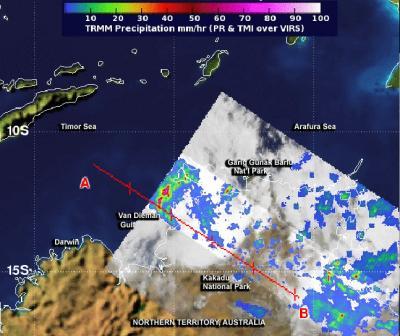The low pressure area designated as System 94S has been trying to organize off the northern coast of Australia's Northern Territory for a couple of days. NASA's TRMM satellite passed overhead on January 14 and saw some areas of heavy rainfall as the low appears more organized.
NASA and the Japan Aerospace Exploration Agency's Tropical Rainfall Measuring Mission satellite known as TRMM measured the rainfall rates occurring in System 94S as it affected the northern coast of Australia's Northern Territory or NT, on January 14 at 0214 UTC/11:44 a.m. local time Darwin/Australia/Jan. 13, 9:14 p.m. EST. System 94S' rains are affecting the Arnhem Region of the Northern Territory.
TRMM measured the heaviest rainfall rates near 2 inches/50 mm per hour over the northeastern Van Dieman Gulf, and just off-shore in the northwestern Arnhem Region of the Northern Territory. TRMM data was used to estimate the heights of the thunderstorms that were dropping that heavy rain. Those storms were about 10 kilometers/6.2 miles high.
TRMM data showed light to moderate rainfall from System 94S stretched from the Van Dieman Gulf east, over Gang Gunak Barlu National Park, and Kakadu National Park, and southeast over Flying Fox, NT on Route 24, Central Arnhem Road.

NASA's TRMM satellite saw heavy rainfall (red) along part of the northern coast of Australia's Northern Territory on January 14.
(Photo Credit: Image : SSAI/NASA, Hal Pierce)
The Australian Government Bureau of Meteorology for the Northern Territory issued a Severe Weather Warning on January 14 for residents in the Darwin-Daly, Arnhem, Roper-McArthur, Victoria River and Barkly Districts, including Darwin and the Tiwi Islands. Those areas can expect damaging winds and heavy rainfall from System 94S.The warning states that squalls with locally damaging wind gusts up to 95 kph/59 mph are expected along the Territory coastline tonight (Tuesday, Jan. 14) and during Wednesday, Jan. 15. For the full text of the warning, visit: http://www.bom.gov.au/cgi-bin/wrap_fwo.pl?IDD20040.txt.
At 12:30 UTC/9:30 p.m. Darwin local time/7:30 a.m. EST on January 14, System 94S was located near latitude 13.7 south and longitude 131.3 east, about 150 kilometers/ 93.2 miles south-southeast of Darwin. System 94S is expected to move in a southwesterly direction, close to the coast near the border between the Northern Territory and Western Australia.
Animated infrared satellite imagery showed there is also fragmented bands of thunderstorms associated with the low-level center, which appears to be developing slowly.
System 94S' low-level center is moving over land, but computer modeling used by the Joint Typhoon Warning Center or JTWC showed that System 94S' center will re-emerge over water in the next day or two. So, the JTWC gives System 94S a medium chance for becoming a tropical depression in the next day.
Source: NASA/Goddard Space Flight Center